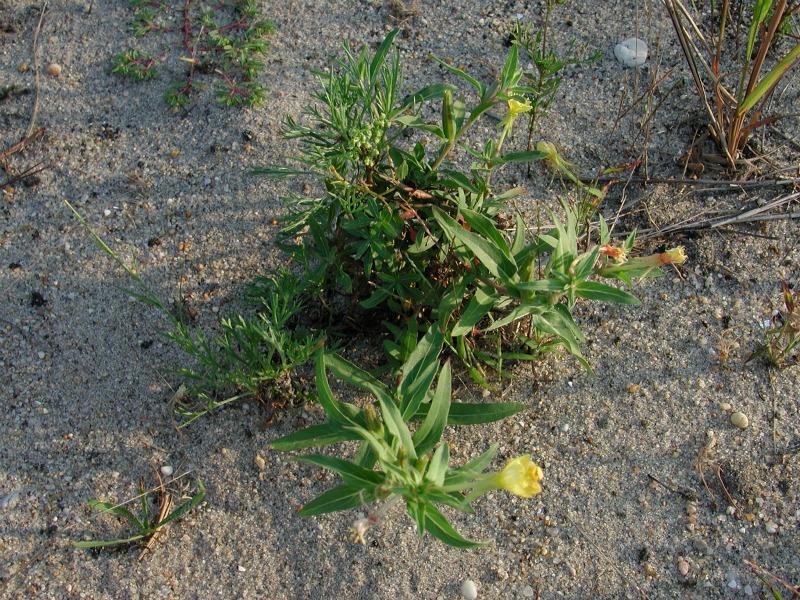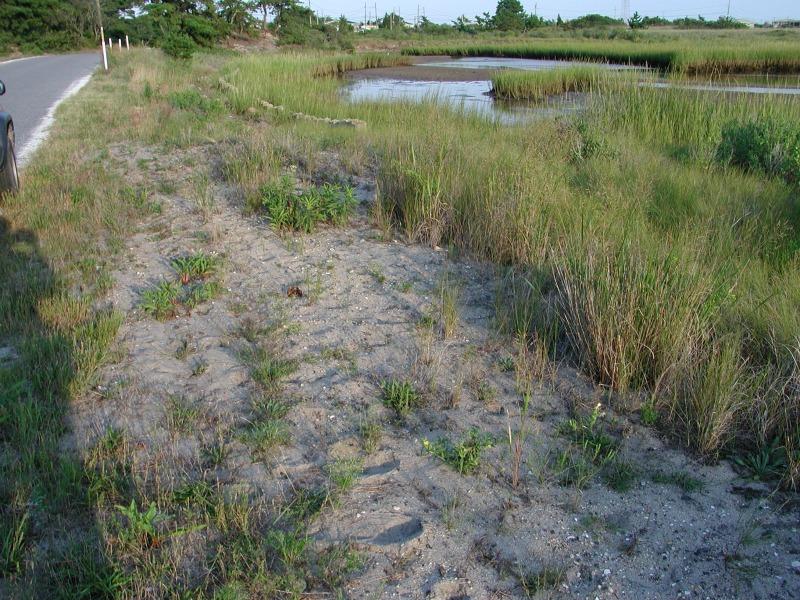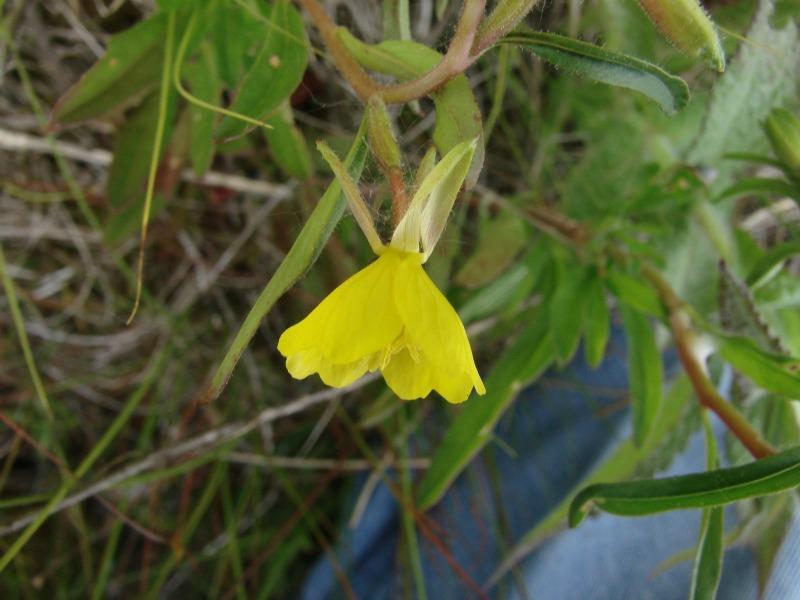Oakes' Evening Primrose
Oenothera oakesiana (Gray) J.W. Robbins ex S. Wats. & Coult.
- Class
- Dicotyledoneae (Dicots)
- Family
- Onagraceae (Evening-Primrose Family)
- State Protection
- Threatened
Listed as Threatened by New York State: likely to become Endangered in the foreseeable future. For animals, taking, importation, transportation, or possession is prohibited, except under license or permit. For plants, removal or damage without the consent of the landowner is prohibited.
- Federal Protection
- Not Listed
- State Conservation Status Rank
- S2
Imperiled in New York - Very vulnerable to disappearing from New York due to rarity or other factors; typically 6 to 20 populations or locations in New York, very few individuals, very restricted range, few remaining acres (or miles of stream), and/or steep declines.
- Global Conservation Status Rank
- G5
Secure globally - Common in the world; widespread and abundant (but may be rare in some parts of its range).
Summary
Did you know?
The species name honors William Oakes (1799-1848), a famous New England botanist who first collected this plant. His career was cut short when he fell overboard from a ferry boat between Boston and East Boston and drowned. His name was used for another New York rare plant, Oakesia conradii, which later was changed to Corema conradii.
State Ranking Justification
There are six existing populations but only two of them have more than 100 plants. Their locations are in disturbed areas which may have a larger effect on population sizes from year to year. There are 26 historical occurrences but many of these have probably been extirpated by development of the open sandy areas.
Short-term Trends
Existing populations seem to be stable at low numbers but most populations have only been surveyed once.
Long-term Trends
Populations seem to be declining from historical numbers but this species is difficult to identify and may move around from one disturbance to another so trends are difficult to assess.
Conservation and Management
Threats
When plants occur along sand roads they are vulnerable to ORV traffic during the growing season. Improper road maintenance activities may also be a problem.
Conservation Strategies and Management Practices
This species needs disturbance to reduce competition from woody plants or more aggressive herbaceous plants but too much direct disturbance to the plants will reduce or eliminate the population. Its habitat could be disturbed in the non-growing season to open it up for seed germination and colonization but direct disturbance should be prevented during the growing season.
Research Needs
Research is needed into the demography of the species on Long Island. Information is needed about how much this species moves around among disturbances and if it establishes a seed bank.
Habitat
Habitat
Most populations of this plant in New York occur on maritime dunes, though there are a few occurrences on disturbed, sandy soils along roadsides or streamsides in pine barrens (New York Natural Heritage Program 2010). Disturbed open places (Gleason and Cronquist 1991). Sandy or rocky shores, dunes, and clearings along the Great Lakes; occasionally inland along railroads, on sandy shores, in clearings or other disturbed places (Voss 1985).
Associated Ecological Communities
- Maritime dunes
(guide)
A community dominated by grasses and low shrubs that occurs on active and stabilized dunes along the Atlantic coast. The composition and structure of the vegetation is variable depending on stability of the dunes, amounts of sand deposition and erosion, and distance from the ocean.
- Maritime pitch pine dune woodland*
(guide)
A maritime woodland that occurs on stabilized parabolic dunes. The substrate is wind and wave deposited sand that is usually excessively well-drained and nutrient poor. The community is subject to high winds, sand-blasting, salt spray, and shifting substrate.
- Mowed roadside/pathway
A narrow strip of mowed vegetation along the side of a road, or a mowed pathway through taller vegetation (e.g., meadows, old fields, woodlands, forests), or along utility right-of-way corridors (e.g., power lines, telephone lines, gas pipelines). The vegetation in these mowed strips and paths may be dominated by grasses, sedges, and rushes; or it may be dominated by forbs, vines, and low shrubs that can tolerate infrequent mowing.
- Pitch pine-oak forest*
(guide)
A mixed forest that typically occurs on well-drained, sandy soils of glacial outwash plains or moraines; it also occurs on thin, rocky soils of ridgetops. The dominant trees are pitch pine mixed with one or more of the following oaks: scarlet oak, white oak, red oak, or black oak.
* probable association but not confirmed.
Associated Species
- Ambrosia artemisiifolia (common ragweed)
- Ammophila breviligulata ssp. breviligulata
- Artemisia vulgaris (mugwort)
- Centaurea stoebe ssp. micranthos (spotted knapweed)
- Conyza canadensis
- Diodia teres (rough buttonweed)
- Erigeron annuus (annual daisy fleabane)
- Lechea maritima
- Lolium perenne
- Myrica gale (sweet gale)
- Panicum virgatum (switch grass)
- Parthenocissus quinquefolia (Virginia-creeper)
- Pinus rigida (pitch pine)
- Plantago aristata (long-bracted plantain)
- Rosa rugosa (Japanese rose)
- Solidago sempervirens (northern seaside goldenrod)
Range
New York State Distribution
This species is most common on Staten Island and Long Island but there are historical records upstate from Fulton, Washington, and Warren counties in the east and Cayuga and Ontario counties to the west.
Global Distribution
This occurs from Newfoundland and Nova Scotia south to North Carolina and Tennessee then northwest to Wisconsin, Minnesota and Ontario.
Identification Comments
General Description
Oenothera oakesiana is an annual herb species with erect or ascending stems simple or branching from the base (the upper portion of the infloresence nodding at the tip), 0.5 to 2 m tall, and covered with long, spreading, whitish hairs. The leaves are gray-green in color, narrowly oblanceolate or elliptic, and entire or remotely toothed. The flowers are sessile, open at twilight, and are borne in the axils of the upper leaves. They have greenish or yellow sepals with red flecks or stripes, connivent at the base, and pale yellow petals 7 to 20 mm long. The fruit are rounded capsules thickest near their bases and 1.5 to 4.0 cm long, containing angular, unpitted seeds (Gleason and Cronquist 1991, Voss 1985, Rhoads 2000).
Best Life Stage for Proper Identification
Plants in flower are easiest to identify, though those with mature fruit may also be identified.
Similar Species
Oenothera oakesiana is closely related to (and formerly considered a variety of) both O. biennis and to O. parviflora. O. biennis is distinguished from O. oakesiana by having its floresence erect to the tip and sepals closely connivent at the base. O. parviflora has brighter green leaves than those of O. oakesiana, and its infloresence has gland-tipped hairs (Rhoads 2000, Voss 1985).
Best Time to See
Oeonother oakesiana flowers in August and into September, and the fruits may persist from September through October.
- Flowering
- Fruiting
The time of year you would expect to find Oakes' Evening Primrose flowering and fruiting in New York.
Oakes' Evening Primrose Images
Images of Similar Species
Taxonomy
Oakes' Evening Primrose
Oenothera oakesiana (Gray) J.W. Robbins ex S. Wats. & Coult.
- Kingdom Plantae
- Phylum Anthophyta
- Class Dicotyledoneae
(Dicots)
- Order Myrtales
- Family Onagraceae (Evening-Primrose Family)
- Order Myrtales
- Class Dicotyledoneae
(Dicots)
- Phylum Anthophyta
Synonyms
- Oenothera parviflora ssp. angustissima (R.R. Gates) Munz
- Oenothera parviflora var. oakesiana (Gray) Fern.
Additional Resources
Best Identification Reference
Gleason, Henry A. and A. Cronquist. 1991. Manual of Vascular Plants of Northeastern United States and Adjacent Canada. The New York Botanical Garden, Bronx, New York. 910 pp.
Other References
Fernald, M.L. 1950. Gray's manual of botany. 8th edition. D. Van Nostrand, New York. 1632 pp.
Holmgren, Noel. 1998. The Illustrated Companion to Gleason and Cronquist's Manual. Illustrations of the Vascular Plants of Northeastern United States and Adjacent Canada. The New York Botanical Garden, Bronx, New York.
Mitchell, Richard S. and Gordon C. Tucker. 1997. Revised Checklist of New York State Plants. Contributions to a Flora of New York State. Checklist IV. Bulletin No. 490. New York State Museum. Albany, NY. 400 pp.
New York Natural Heritage Program. 2010. Biotics database. New York Natural Heritage Program. New York State Department of Environmental Conservation. Albany, NY.
New York Natural Heritage Program. 2024. New York Natural Heritage Program Databases. Albany, NY.
Voss, E.G. 1985. Michigan flora. Part II. Dicotyledons. Cranbrook Institute of Science and University of Michigan Herbarium. Ann Arbor, Michigan. 1212 pp.
Weldy, T. and D. Werier. 2010. New York flora atlas. [S.M. Landry, K.N. Campbell, and L.D. Mabe (original application development), Florida Center for Community Design and Research http://www.fccdr.usf.edu/. University of South Florida http://www.usf.edu/]. New York Flora Association http://newyork.plantatlas.usf.edu/, Albany, New York
Links
About This Guide
Information for this guide was last updated on: February 28, 2011
Please cite this page as:
New York Natural Heritage Program. 2024.
Online Conservation Guide for
Oenothera oakesiana.
Available from: https://guides.nynhp.org/oakes-evening-primrose/.
Accessed July 26, 2024.


